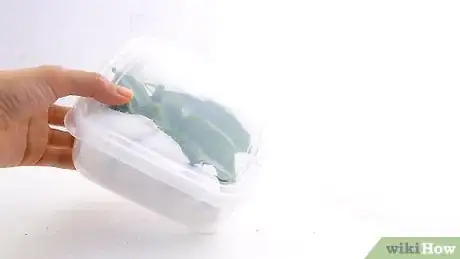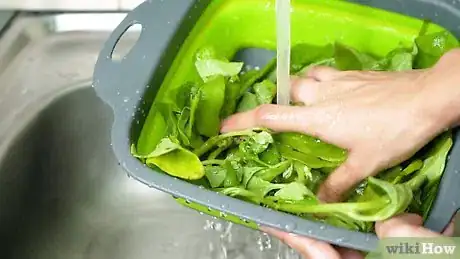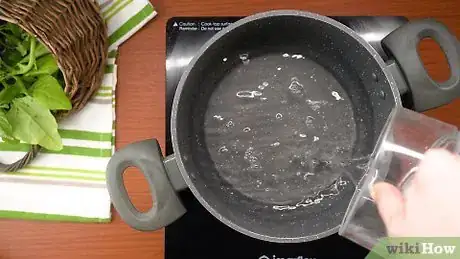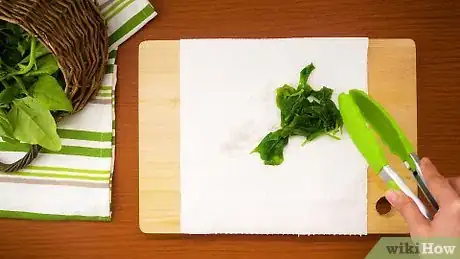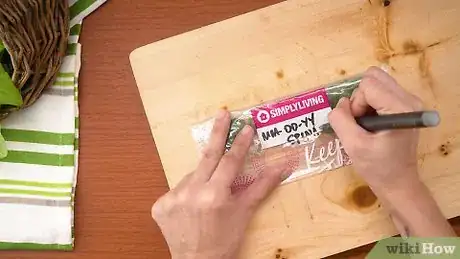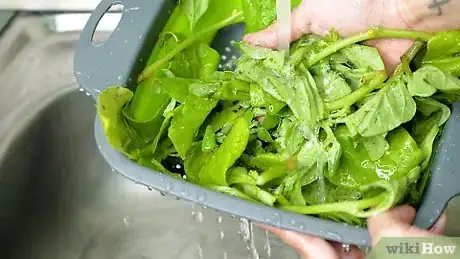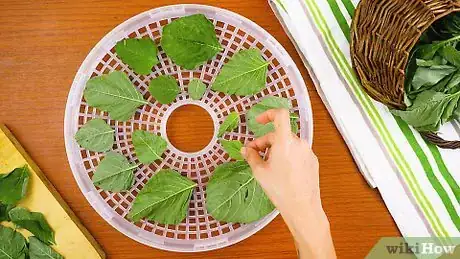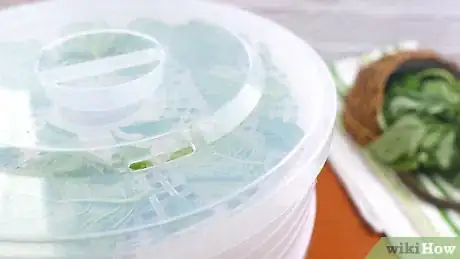This article was co-authored by wikiHow staff writer, Hunter Rising. Hunter Rising is a wikiHow Staff Writer based in Los Angeles. He has more than three years of experience writing for and working with wikiHow. Hunter holds a BFA in Entertainment Design from the University of Wisconsin - Stout and a Minor in English Writing.
There are 9 references cited in this article, which can be found at the bottom of the page.
The wikiHow Video Team also followed the article's instructions and verified that they work.
This article has been viewed 10,591 times.
Learn more...
Spinach is a great leafy green to incorporate into your diet since it contains many healthy vitamins and minerals. Spinach usually stays good for about a week in the fridge, but there are other simple ways you can preserve it for longer. Frozen spinach retains its flavor the best, but it may lose some of its texture. You can also dry your spinach if you want to easily mix it into your dishes and make them healthier!
Steps
Storing Fresh Spinach in the Fridge
-
1Spread the spinach on a cutting board to sort out discolored or soft pieces. Pour your spinach out onto a cutting board or clean pieces of paper towel. Pick out leaves that have a dark green or white color since they have started to spoil or are unhealthy growths. Throw away any pieces that feel slimy or soft as well since they won’t keep well.
- Spinach that’s going bad may also have a foul odor.
-
2Pat the spinach dry using paper towels to prevent wilting. Keep the spinach in a flat, even layer so the leaves don’t overlap. Place pieces of paper towel on top of the spinach and press down firmly to absorb any moisture that’s still on the leaves. If the paper towel soaks through, use a new piece until you get the spinach as dry as possible.
- You don’t need to rinse your spinach right away since you could make it wilt faster.
Advertisement -
3Line a resealable airtight container with paper towels. Pick a container or plastic bag that’s large enough to hold all of your spinach leaves. Put a couple of layers of paper towel on the bottom of the container. Fold more paper towels and wrap them around the sides of the container to help capture more moisture.[1]
- Alternatively, you can wrap the pieces of spinach in a paper towel instead of the container.
Warning: Avoid leaving packaged spinach inside the original bag or container since it usually traps moisture and will spoil faster.
-
4Seal the spinach inside of the container. Place the dry spinach leaves on top of the paper towels to help absorb any moisture that’s still stuck on the leaves. It’s okay if you stack or overlap the pieces since they’ll stay dry. Put the lid on the container to protect them from foreign germs or bacteria.[2]
- Avoid leaving the spinach uncovered since it could easily get contaminated.
-
5Wash and dry the spinach right before you eat it. Whenever you want to use your spinach, run it underneath cold water to help remove any dirt that might be left on the surface. Use paper towels to pat the spinach dry, or put it in a salad spinner to get rid of the excess moisture.[3]
- Some packaged spinach comes prewashed, so you don’t need to rinse it unless it’s visibly dirty.
-
6Keep spinach in your fridge for 5–7 days before getting rid of it. Continue using the spinach as long as it’s still fresh. Once it starts to turn a dark green, give off a foul odor, or feel slimy to the touch, throw the spinach and the paper towel lining the container away.[4]
Blanching and Freezing Spinach
-
1Rinse your spinach under cold water. Use the coldest water from your faucet and let it wash over your pieces of spinach. Rub off any bugs or dirt on the leaves before shaking off the excess moisture. Set the spinach on paper towels to absorb some of the water.[5]
- Avoid using hot water since you could cause the leaves to wilt.
-
2Chop the spinach into bite-sized pieces with a chef’s knife if you want to. Lay the leaves on a cutting board and chop off any thick stems that you don’t want to eat. Try to make the larger leaves the same sizes as the smaller ones so they’re easier to store and cook with later on.[6]
- You can leave the stems on your spinach pieces since they’re good sources of fiber, but they may have a tougher texture than the rest of the leaf.
-
3Boil 1 US gal (3.8 L) of water on your stove. Use a tall pot so you can completely submerge the spinach leaves. Turn the stove to high heat and wait until the water comes to a rolling boil.[7]
-
4Blanch the spinach for 2 minutes. Add 4 cups (900 g) of your spinach into the pot and let it return to a boil. Put a cover on the pot and allow the spinach to cook for 2 minutes, or until it has a vibrant green color.
- Blanching your spinach helps preserve the flavor and makes the pieces easier to freeze.
-
5Dunk the spinach in a bowl of ice water using tongs for 90 seconds. Fill a large bowl with ice cubes and cold water and keep it near your stove. Scoop the spinach out of the pot with a pair of tongs and completely submerge it in the cold water. Leave the spinach in the bowl for another 90 seconds so it stops cooking.[8]
- If the water starts to warm up, add more ice cubes to keep it cold.
-
6Drain the spinach into a colander. Place a colander in the bottom of your sink and pour the bowl of water into it. Scoop out the ice cubes and throw them away so they don’t melt on the spinach. Lightly press on top of the spinach to force more moisture out from between the leaves.
- If you don’t have a colander, then use a slotted spoon to take your spinach out of the bowl and let the excess water drip off.
- Don’t leave the spinach in the ice water for any longer since it may affect the texture.
-
7Lay the spinach out and pat it dry with paper towels. Spread a layer of paper towel out on your counter and spread the spinach pieces out so they don’t overlap. Set another layer of paper towels on top of the leaves and apply firm pressure to squeeze out any water that’s still on them. If the paper towels soak through, replace them with dry pieces until you don’t lift up any more moisture.[9]
- Drying the spinach prevents the pieces from freezing together so they’re easier to pull apart.
-
8Put the spinach in an airtight freezer-safe bag or container. Pick a bag or container that’s specifically made to use in your freezer so your spinach is less likely to get freezer burn. Pack the spinach into the container, leaving about 2 inches (5.1 cm) of space between it and the top. That way, the container won’t freeze shut.[10]
- If you’re using resealable bags, try to squeeze out as much air as you can to help save more space inside your freezer.
Variation: You may also pack the spinach into ice cube trays so you can have easy single servings. This works great for adding spinach to stir fry, pasta, soups, or smoothies.
-
9Label and date the containers and keep them frozen for up to 12 months. Use a marker to write today’s date and the contents of the container so you don’t forget. Keep the container in your freezer until you’re ready to use the spinach. When you’re ready, put the frozen spinach directly in your dish while it’s cooking without thawing it.[11]
- You can keep spinach in your freezer indefinitely, but it has the best flavor if you use it within 12 months.[12]
- Frozen spinach won’t have the same texture as fresh spinach, so plan on using it in cooked dishes, such as pasta or casseroles
Dehydrating Spinach
-
1Rinse your spinach under cold water. Put all of the spinach leaves in a colander and run it under cold water. Stir the leaves around the colander to ensure that you rinse all of the pieces evenly. If you notice pieces that have a lot of dirt, use a clean paper towel to wipe them clean. Let the excess water drip off of the leaves when you’re finished.[13]
- If you bought pre-washed spinach, you don’t need to rinse off the leaves.
Warning: Don’t use hot water since you could make the leaves wilt.
-
2Spread out the spinach and dry them with paper towels. Lay paper towels down on your countertop and pour the spinach leaves on top of it. Separate the leaves so they don’t overlap to help absorb the most moisture. Set another piece of paper towel on top of the spinach and press down firmly until you get rid of all the water left on the leaves.[14]
- Even if you didn’t wash your spinach, be sure to dry it since moisture may have been trapped in the packaging.
-
3Trim the stems off of the leaves using kitchen scissors. If you leave the stems on, the leaves will dry out and the stems will still have a tough texture. Place the scissors where the stem meets the leaf and make your cut. Continue removing the rest of the stems from your spinach before throwing them away.[15]
- You can also cut the spinach pieces into bite-sized pieces if you want to.
-
4Lay the spinach on dehydrator trays so they don’t overlap. Take the trays out of your dehydrator and place your spinach leaves on them. Make sure the leaves don’t overlap or they won’t dry out as evenly. Fit as many leaves as you can on each tray before putting them back in the dehydrator.[16]
- You can buy a dehydrator online or at home goods stores.
-
5Leave the spinach in the dehydrator at 125 °F (52 °C) for 3–4 hours. Turn the dehydrator on and set the temperature to 125 °F (52 °C). Avoid opening the dehydrator while your spinach dries out since it won’t retain heat as well. After 3 hours, check your spinach to see if it has a crispy, flaky texture. If not, leave it in for another 15–20 minutes before checking again.[17]
- Be careful not to leave your spinach in for any longer since you may affect the flavor.
-
6Store the dried leaves in a resealable container as long as you need them. Choose a resealable container or bag and carefully put the leaves inside. Be careful not to break them apart if you want to incorporate whole pieces into your recipe. Otherwise, you can crumble the pieces into a spinach powder so it’s easy to spread in your dishes.[18]
- You can store dried spinach for as long as you want.
- Dried spinach or spinach powder works great for mixing into smoothies, pasta, casseroles, and other vegetables.
Warnings
- Avoid eating spinach if it’s soft, mushy, or discolored since it’s starting to spoil. If the spinach has a foul odor or a slimy texture, throw it away.[19]⧼thumbs_response⧽
Things You’ll Need
Storing Fresh Spinach in the Fridge
- Paper towels
- Resealable bag or container
Blanching and Freezing Spinach
- Sink
- Chef’s knife
- Cutting board
- Pot
- Stove
- Tongs
- Bowl
- Ice
- Colander
- Paper towels
- Freezer-safe bag or container
- Marker
Dehydrating Spinach
- Colander
- Sink
- Paper towels
- Dehydrator
- Resealable bag or container
References
- ↑ https://hnr.k-state.edu/doc/hort-tips/vegetables/Spinach.pdf
- ↑ https://www.kitchensanity.com/food-prep/how-to-store-spinach/
- ↑ https://extension.umn.edu/food-service-industry/wash-or-not-wash-recommendations-fresh-produce
- ↑ https://hnr.k-state.edu/doc/hort-tips/vegetables/Spinach.pdf
- ↑ https://extension.umn.edu/preserving-and-preparing/freezing-leafy-greens-later-use
- ↑ https://extension.umn.edu/preserving-and-preparing/freezing-leafy-greens-later-use
- ↑ https://extension.umn.edu/preserving-and-preparing/freezing-leafy-greens-later-use
- ↑ https://extension.umn.edu/preserving-and-preparing/freezing-leafy-greens-later-use
- ↑ https://extension.umn.edu/preserving-and-preparing/freezing-leafy-greens-later-use
- ↑ https://extension.colostate.edu/topic-areas/nutrition-food-safety-health/freezing-vegetables-9-330/
- ↑ https://extension.colostate.edu/topic-areas/nutrition-food-safety-health/freezing-vegetables-9-330/
- ↑ https://nchfp.uga.edu/how/dry/csu_dry_vegetables.pdf
- ↑ https://nchfp.uga.edu/how/dry/csu_dry_vegetables.pdf
- ↑ https://extension.umn.edu/preserving-and-preparing/freezing-leafy-greens-later-use
- ↑ https://nchfp.uga.edu/how/dry/csu_dry_vegetables.pdf
- ↑ https://nchfp.uga.edu/how/dry/csu_dry_vegetables.pdf
- ↑ https://extension2.missouri.edu/gh1563
- ↑ https://extension2.missouri.edu/gh1563
- ↑ https://www.stilltasty.com/fooditems/index/18375
About This Article
Freezing spinach is a great way to store it long-term without sacrificing the flavor. First you'll want to blanch the spinach by cutting it into bite-size pieces and boiling it for 2 minutes. Immediately transfer the spinach to a bowl of ice water so it stops cooking. Then, drain it in a colander and pat it dry between two paper towels. Place the spinach in an airtight, freezer-safe container or bag and store it in the freezer for up to 12 months. To learn how to store spinach in the fridge and how to dehydrate spinach, check out the full article!

